When trying to figure out which would be better suited to you – a canoe vs kayak – the worst thing you could do is ask a room of paddlers what they think. Why, you ask? Well, the ensuing debate could take all night and by the end of it you may have turned old friends into sworn enemies!
Naw, things shouldn’t end up so badly. But you are guaranteed to get bombarded with information (from biased individuals) and may be asked to choose a side. It’s probably better to make this kind of decision yourself, and with the help of an unbiased source.
So I’ve compiled a list of the main differences between a canoe vs kayak. From how they’re built and what activities you can use them for, to where you can take them and what the advantages of each are.
Physical Form – Seating Area and Depth
At a glance, one can normally tell the difference between canoe vs kayak by looking at the cockpit, or seating area.
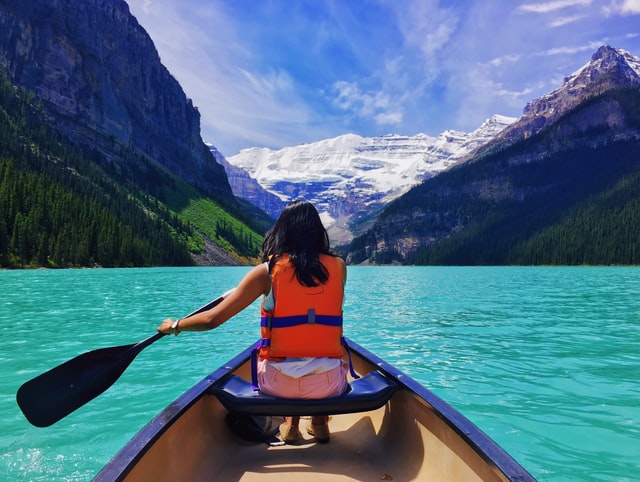
Canoes are bigger and broader and have a similar design to traditional row boats. With canoes, the sides are quite high in relation to how far they are from the water.
Canoes also have what’s referred to as an ‘open cockpit’. This is a space for sitting that’s not enclosed, which allows paddlers to move around freely. These vessels have what look like benches or slats. They are positioned high above the floor for two or more paddlers to sit or kneel on.
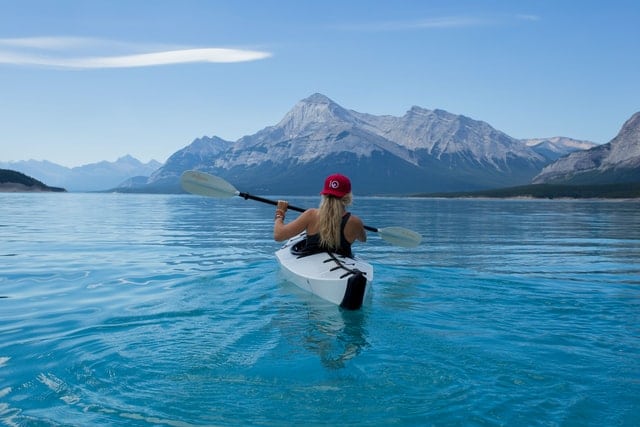
The body of a kayak is sleek and has much less depth than a canoe. They rise above the water surface only slightly. A kayak has what’s called a ‘closed cockpit’ design. This means the paddler’s legs are nestled inside the body of the vessel (in the sit-in kayak variety).
There is also the sit-on-top kayak variety, that has no enclosed cockpit area. The seats are created from shallow hollows moulded into the surface of the vessel where your buttocks and legs are placed. In this kayak type, the paddler just keeps their legs straight out in front of them. Sometimes they have plastic seats built in for extra comfort and lower back support. This feature becomes necessary if you want to go out for longer day trips or go touring for a number of days.
Types of Paddles
The paddle of a canoe is shorter than that of a kayak. It consists of a T-shaped handle on one end and a broad, flat blade on the other.
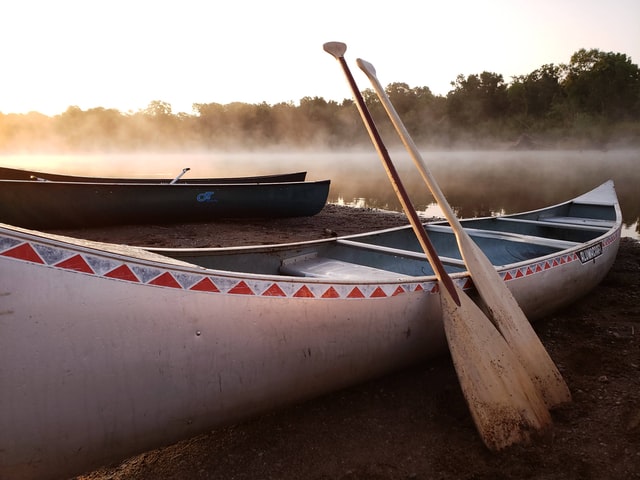
You can paddle on both sides of the canoe, alternating strokes to avoid going in circles. You can read more about choosing the right canoe paddle here.
With some practice, you can learn the so-called “J-stroke”. This is a neat little trick that involves only paddling on one side and allows you to cut through the water in a straight line. This is a crucial technique to learn if you’re getting a canoe, but don’t want to have to paddle on both sides. It is a very inefficient way of using your energy to alternate sides for extended periods of time.
Kayaks, on the other hand, come with a much longer double-ended paddle. To propel forward, kayakers hold onto the bar with both hands and alternate dipping each blade into the water.

You can read more about choosing the right kayak paddle here.
To an absolute beginner, the kayak paddle is easier to handle and requires less effort than a canoe. Keep in mind that, while it takes longer to learn the proper techniques for handling a canoe, it is generally more comfortable to paddle a canoe. A canoe usually has two people paddling at once as well. While you can buy a tandem kayak, most kayaks are for one paddler.
Can You Do More in a Kayak or Canoe?
Where you plan to take your watercraft and how you intend to use it are crucial factors when choosing a kayak vs canoe.
Both kayaks and canoes are fine for recreational paddling on calmer waters. However, there are some features of each that make them ideal for particular water body types or specialized activities.
Canoes have better load-carrying capacity, both in terms of passenger numbers and items you want to bring with you. So if you want to bring food and camping gear, then a canoe is probably right for you.
There are some kayaks with a fair amount of built-in dry storage space too, but these are better suited to more adventurous and adrenaline-fuelled activities. These include whitewater kayaking, paddling on the ocean, and fishing in deep waters.
If you plan to spend the better part of a day angling with your buddies, then a canoe’s more spacious dimensions let you stretch out and move around while you wait for a bite. That said, there are also kayaks made just for the serious fisherman. In recent years some kayak models have been made with deep wells for fishing kits, stabilizing outriggers, and built-in rod holders.
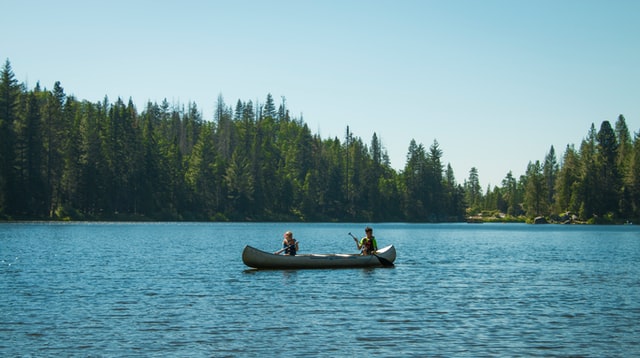
For freshwater fishing in shallow areas of lakes and streams both kayaks and canoes are excellent and I prefer them to traditional fishing boats which cannot make their way into shallow areas without running aground. Kayaks and canoes each ride very high in the water, so they’re ideal for getting to and fishing places most traditional boats cannot navigate to.
Comparing Your Comfort Paddling a Canoe vs Kayak
If you live in an area that gets really cold, you obviously want a vessel that keeps you relatively dry so that you don’t catch a chill.
- Canoes, thanks to their being higher off the water, are far better at keeping water out of the boat.
- Kayaks, on the other hand, are safer and easier to manage if you’re paddling over waves.
If you have a sit-in kayak, then you can simply attach a spray-skirt around the cockpit rim, which will create a water-tight barrier. How much water gets on the exposed part of your upper body will depend on your paddling technique and the wind, but I recommend a wet suit or dry suit in cold weather when in a kayak.
Personally, I prefer canoeing in cooler weather. I can wear my regular clothing and stay dry while enjoying the foliage in fall or getting in some early spring fishing.
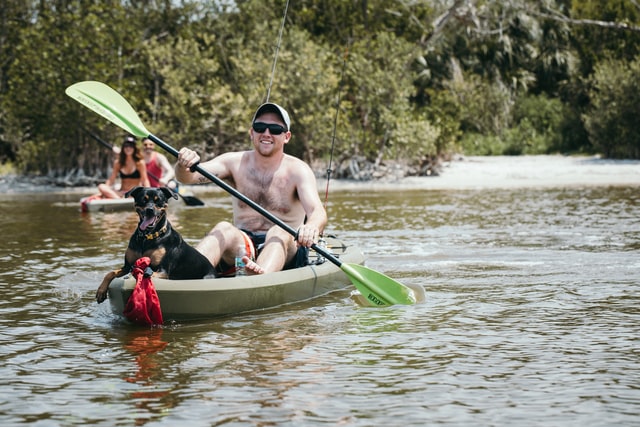
If you live in a place with warm temperatures (or are looking for a boat for your summer camp), then you might want to consider getting a sit-on-top kayak, which gets you rather wet (but this doesn’t matter so much when a splash of water is refreshing). Besides, sit-on-top kayaks are the easiest for slipping in and out of the water, so you can take a break from paddling at any time to go for a swim.
Top 5 Advantages of Canoes and Kayaks
Canoe Benefits
- It’s easier to get in and out of them.
- Their height gives you a better view of what’s around you.
- They’re better for longer expeditions.
- Their size lets you accommodate small children and pets.
- Canoes are easier to carry on-land when going between bodies of water (portaging).
Kayak Benefits
- If you capsize, kayaks are easier to set back upright.
- They’re better at maneuvering and handling whitewater.
- It’s not hard to learn the basic techniques and you can paddle on your own.
- Kayaks weigh less and it’s easier to transport them.
- They offer you more speed while requiring less effort than paddling a canoe.
So Which is Better Suited for You – a Canoe or Kayak?
Now that you know a bit more about the biggest differences between these two watercraft types, you’re one step closer to discovering which one is right for you.

In case you’re still not sure, here are a few questions to ask yourself:
- Who will be paddling with you? If you’re going with a partner or group, go for a canoe. Kayaks are better for solo paddlers.
- Do you want to go for quick water excursions that fit into your busy schedule, or longer trips at a relaxed pace? Kayaks may be better for a quick escape, while canoes allow for more leisurely trips.
- What car will you use to transport the boat? If you have a truck or sedan with a roof rack, you can accommodate a canoe. If your car is small then a kayak is better.
And if you’re still unsure of which one you want, I suggest you take both a canoe and a kayak for a test drive. See if any local water sports clubs will be willing to let you try theirs out. If not, find a location that offers rentals.


